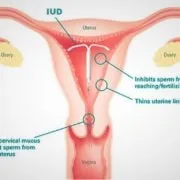Brown Vaginal Discharge: Causes, Treatment, and When to get Tested
Brown vaginal discharge is a common experience for many women, often occurring at some point in their lives. Typically, this discharge is not a cause for concern, especially when it appears before or after a menstrual period. However, when brown discharge is accompanied by other symptoms or presents itself in unusual ways whether in amount, consistency, timing, or color it could be indicative of an underlying health condition that requires attention. In this article, will discuss the most common causes of brown vaginal discharge, the testing options available, treatment modalities, and when it’s necessary to consult a doctor.
What Is Normal Vaginal Discharge?
Vaginal discharge is a normal and healthy bodily function experienced by women. It is produced by the vaginal cells and the normal bacteria residing on the vaginal surface, playing a critical role in maintaining a healthy vaginal environment. Discharge, also known as cervical mucus, naturally changes throughout different phases of the menstrual cycle.
Typically, women produce about half a teaspoon to one teaspoon (2-5 ml) of vaginal discharge daily. This discharge is usually white or clear, odorless, and has a mucus-like consistency. The characteristics of normal vaginal discharge can vary significantly from one woman to another, making it essential for each woman to recognize what is normal for her. Sudden changes in the nature of vaginal discharge could signal that something is wrong.
How Brown Vaginal Discharge Gets Its Color?
The brown color observed in vaginal discharge often results from the presence of blood that has been exposed to oxygen in the air. This is due to a natural process called oxidation, which changes the color of the blood from red to brown.
The uterus and vagina are rich in blood vessels, particularly around the time of a menstrual period. A small amount of blood may mix with vaginal fluid, resulting in a brownish discharge. The shade of brown can vary depending on the amount of blood present and the duration of its exposure to air before being expelled from the body. The more blood present and the longer it has been exposed to oxygen, the darker the discharge will appear.

Understanding Different Shades of Brown Discharge
- Light Brown Vaginal Discharge: Light brown discharge typically indicates light bleeding or spotting. This is most common at the beginning or end of a menstrual period or when associated with other conditions that cause light bleeding.
- Dark Brown Vaginal Discharge: Dark brown discharge usually suggests more significant bleeding, commonly occurring during a menstrual period or due to other conditions that involve substantial blood loss.
Common Causes of Brown Vaginal Discharge
1. Hormonal Fluctuations and the Menstrual Cycle
Brown Vaginal Discharge During a Normal Menstrual Cycle. The light bleeding that often marks the beginning or end of a menstrual period may take on a brownish hue due to oxidation as it travels slowly from the uterus through the vagina to the outside of the body. This brown discharge typically lasts for one to two days. Other common symptoms associated with the menstrual cycle include:
- Cramps
- Bloating
- Fatigue
- Breast tenderness
- Pimple breakouts
- Mood swings
Brown Vaginal Discharge with Mid-Cycle Spotting or Ovulation. Some women experience brown discharge during ovulation, the time in the menstrual cycle when an egg is released from the ovaries. This occurs because estrogen levels, which are usually high during ovulation, suddenly drop, leading to spotting or light bleeding. This type of brown discharge generally lasts one to two days. Additional signs and symptoms of ovulation may include:
- Increased vaginal discharge
- Lower abdominal discomfort
- A slight rise in resting body temperature
Brown Vaginal Discharge Due to Birth Control Pills or Intrauterine Devices (IUDs). The insertion of an IUD can cause slight spotting and subsequent brown vaginal discharge due to minor trauma during the insertion process. Similarly, birth control pills can cause hormonal changes that affect the menstrual cycle, leading to spotting, breakthrough bleeding, and brown discharge. These side effects are usually temporary and should subside after a few months as the body adjusts to the hormonal changes.
If birth control pills are taken inconsistently, this can also lead to temporary spotting and brown discharge.
2. Minor Trauma
Minor trauma to the vaginal or uterine area can cause light bleeding or spotting, leading to brown vaginal discharge. This can occur after a routine Pap smear, IUD insertion, or even vigorous or prolonged sexual activity. Trauma-induced vaginal discharge typically lasts for a day or two.
3. Infections: Sexually Transmitted Diseases (STDs) and Non-STDs
Both sexually transmitted diseases (STDs) and non-STD infections can cause brown vaginal discharge. For sexually active women, it is crucial to rule out infections as a possible cause.
Sexually Transmitted Diseases (STDs). Three common STDs that can lead to brown vaginal discharge are chlamydia, gonorrhea, and trichomoniasis.
- Chlamydia: Caused by bacteria, chlamydia can cause minor spotting, which may lead to brown discharge. Other symptoms include painful urination, unusual vaginal discharge, bleeding during intercourse or between periods, and painful sex. For more information see “Chlamydia: Causes, Symptoms, Treatment & Prevention“.
- Gonorrhea: Also caused by bacteria, gonorrhea primarily affects the cervix but can occasionally lead to brown discharge. Other symptoms include painful urination, vaginal discharge, bleeding during intercourse or between periods, and abdominal and pelvic pain. For more information about Gonorrhea see “Gonorrhea: Symptoms, Treatment & Prevention“.
- Trichomoniasis: This STD is caused by parasites and can result in brown discharge. Symptoms include a significant amount of thin, gray, smelly vaginal discharge, pain during urination or sex, redness and itching of the genitals, and lower abdominal discomfort. For more details see “Trichomoniasis (Trich): Causes, Symptoms, Diagnosis & Treatment“.
Pelvic Inflammatory Disease (PID). PID is a serious infection that can sometimes result in brown discharge. It occurs when sexually transmitted bacteria, primarily chlamydia and gonorrhea, spread from the vagina to the uterus, fallopian tubes, and ovaries. PID can develop gradually from an untreated STD. Common symptoms of PID include:
- Lower abdominal and pelvic pain
- Unusual or heavy vaginal discharge
- Pain during sex or urination
- Fever and chills
Non-STD Infections. Two common non-STD infections that can lead to brown discharge are bacterial vaginosis (BV) and yeast infections (candidiasis). Both conditions result from an imbalance in the vaginal pH.
- Bacterial Vaginosis (BV): BV is caused by an overgrowth of normal vaginal bacteria, disrupting the natural balance. Symptoms include thin, gray vaginal discharge, a foul smell (often described as “fishy”), vaginal itching, burning sensations, and pain during urination. For more information about Bacterial Vaginosis see “Bacterial Vaginosis: Causes, Symptoms, and Treatments“.
- Vaginal Yeast Infection: A yeast infection is caused by the overgrowth of a fungus called Candida. It can lead to brown discharge, especially if the discharge mixes with blood. Symptoms include redness and swelling of the vulva and vagina, intense itching, thick white discharge with a cottage cheese-like appearance, and burning during urination or intercourse. For more information about Vaginal Yeast Infection see “Vaginal Yeast Infections: Symptoms, Causes and Treatment“.
4. Foreign Body in the Vagina
A foreign body in the vagina, such as a forgotten tampon or a piece of a broken condom, can cause brown discharge due to minor bleeding. Other symptoms may include vaginal itching, foul-smelling discharge, pain during urination, and pelvic pain or pressure.
Medical Conditions Associated with Brown Vaginal Discharge
1. Ovarian Cysts
Ovarian cysts are fluid-filled sacs that develop on the surface of an ovary. While most cysts are asymptomatic and harmless, some may twist or rupture, leading to discomfort or significant symptoms. Large ovarian cysts can cause irregular brown discharge due to bleeding.
Other symptoms of ovarian cysts may include:
- Intermittent pelvic pain
- A feeling of fullness or pressure in the abdomen
- Bloating
2. Polycystic Ovarian Syndrome (PCOS)
PCOS is a hormonal disorder affecting women of reproductive age. The condition is characterized by an imbalance of reproductive hormones, leading to irregular or missed periods. Brown discharge instead of a regular period is one of the symptoms of PCOS.
Other common symptoms of PCOS include:
- Excess hair growth
- Acne
- Dark patches of skin
- Obesity
- Ovarian cysts
- Infertility
3. Endometriosis
Endometriosis is a painful condition in which tissue similar to the lining of the uterus grows outside the uterus. The ovaries, fallopian tubes, and colon are the most commonly affected areas. Brown discharge may occur due to bleeding from the endometrial tissue.
Other symptoms of endometriosis include:
- Pain during periods
- Painful intercourse
- Pain during bowel movements or urination
4. Cervical Cancer
Cervical cancer is a serious condition often caused by certain strains of the human papillomavirus (HPV). While cervical cancer is not a common cause of brown discharge, it can occasionally present with this symptom.
Other symptoms of cervical cancer may include:
- Heavy or prolonged periods
- Bloody, foul-smelling vaginal discharge
- Painful intercourse
- Unexplained weight loss
Pregnancy-Related Causes of Brown Vaginal Discharge
1. Implantation
Implantation occurs when a fertilized egg attaches to the lining of the uterus. This process can cause minor bleeding, which may present as brown discharge. Implantation typically occurs one to two weeks after conception.
Other early signs of pregnancy may include:
- Nausea and vomiting
- Breast tenderness
- Bloating
2. Pregnancy
Increased vaginal discharge is normal during pregnancy. About 30% of pregnant women experience brown discharge, especially during the first trimester. For more details see “Vaginal Discharge During Pregnancy“.
3. Ectopic Pregnancy
An ectopic pregnancy occurs when a fertilized egg implants outside the uterus, typically in the fallopian tube. This is a medical emergency that requires immediate attention. Symptoms of an ectopic pregnancy include:
- Sharp pelvic or abdominal pain on one side
- Dizziness or fainting
- Pain in the lower abdomen or pelvis
- Irregular vaginal bleeding
- Shoulder pain
Tests to Determine the Cause of Brown Vaginal Discharge
If you experience brown discharge, your healthcare provider will likely begin with a thorough medical history and physical examination. If necessary, further testing may include:
- A pelvic exam
- A Pap smear
- An STD test
- Blood tests
- A pelvic ultrasound
- A colposcopy
- A biopsy
Treatment Options for Brown Vaginal Discharge
The treatment for brown vaginal discharge depends on the underlying cause. After an accurate diagnosis, your healthcare provider will recommend the most appropriate treatment plan.
For example:
- Antibiotics may be prescribed for bacterial infections like BV, chlamydia, gonorrhea, or PID.
- Antifungal medications may be used to treat yeast infections.
- Hormonal treatments may be recommended for hormonal imbalances related to PCOS or menopausal changes.
- Surgery may be necessary for conditions like ovarian cysts or endometriosis.
When to See a Doctor
While brown vaginal discharge is often harmless, there are times when it’s essential to seek medical attention. Consult your healthcare provider if:
- Brown discharge occurs after menopause.
- Discharge is accompanied by other symptoms, such as pain, itching, or an unusual odor.
- You experience prolonged or heavy bleeding.
- You suspect you might be pregnant.
- You have a history of cancer or other significant medical conditions.
FAQs
What causes brown vaginal discharge after sex?
Brown vaginal discharge after sex is often due to light bleeding from the cervix or vaginal walls, which can be irritated during intercourse. This can also be a sign of infections like chlamydia or gonorrhea, or cervical polyps. If the discharge persists or is accompanied by pain or an unusual odor, it’s best to seek medical advice.
Why Do I Have Brown Discharge but No Period?
Brown vaginal discharge without a period is usually a result of old blood exiting the body, which can occur for several reasons. It may be due to light spotting between periods, hormonal fluctuations, or the start or end of your menstrual cycle. In some cases, it could be linked to ovulation, early pregnancy (implantation bleeding), or even the use of contraceptives. Stress, changes in lifestyle, or minor infections might also contribute. While brown discharge is typically harmless, if it’s accompanied by unusual symptoms like pain, odor, or persistent spotting, it’s a good idea to consult a healthcare professional for further evaluation.
Is light brown discharge before my period something to worry about?
Light brown discharge before your period is generally not a cause for concern. It usually occurs due to old blood from the previous cycle being expelled. However, if you frequently experience this, or if it’s accompanied by pain or other symptoms, it’s advisable to consult a healthcare provider.
Why do I have brown vaginal discharge with itching?
Brown vaginal discharge accompanied by itching is often a sign of an infection, such as bacterial vaginosis or a yeast infection. These infections can alter the pH of the vagina, leading to abnormal discharge and irritation. If you experience these symptoms, it’s important to get tested and treated.
Should I be concerned about dark brown vaginal discharge after my period?
Dark brown vaginal discharge after your period is usually a result of the uterus expelling old blood. However, if this discharge continues for an extended period, or is associated with unusual symptoms like a foul odor or pelvic pain, it could be a sign of an underlying condition such as an infection or hormonal imbalance.
Is brown vaginal discharge after menopause normal?
Brown vaginal discharge after menopause can be a cause for concern. It may indicate conditions such as endometrial atrophy orendometrial hyperplasia or, in rare cases, endometrial cancer. If you notice any brown discharge after menopause, it is essential to consult a healthcare provider for a thorough examination.
Conclusion
Brown vaginal discharge can be a normal part of the menstrual cycle, but it can also be a sign of an underlying health condition. Understanding the various causes and associated symptoms can help you determine when to seek medical advice. Always consult a healthcare professional if you have concerns or notice changes in your vaginal discharge, particularly if it is accompanied by other symptoms. Early diagnosis and treatment can prevent complications and promote overall health.










